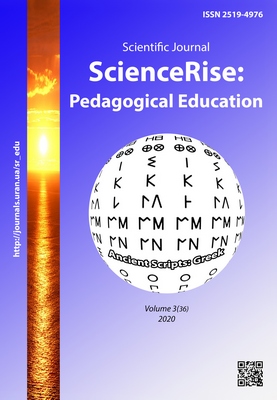Interactive methods of social and pedagogical work and the efficiency of their use in the community service centers for families, children and youth activity
DOI:
https://doi.org/10.15587/2519-4984.2020.199824Keywords:
methods of interactive learning, brainstorming, training, role play, educational process participantAbstract
In the modern society, the children’s upbringing and development is considered to replace traditional “cumulative” education with “problem-defining” training, as under such conditions, pupils are engaged in real life problems, being able to independently analyse and solve life issues and not only get theoretical information from a teacher. From the point of social work as a science, such practice is a great prospect for the younger generation future life, as it forms the autonomy and adequate self-actualization of an individual in the society from the school years.
Acting on their own, applying their knowledge and skills in practice, pupils obtain some social experience, the motivation to plan their lives and an understanding of responsibility for personal well-being appear. In the process of an interactive learning, pupils and teacher are in the mode of conversation, dialogue with each other, and they are equal. Such an interaction implies the one participant dominance in the educational process over another, one point over another.
In the context of problem-based education, learning will be more successful if students formulate the tasks independently and, based on their own life experience, fulfil them. Interactive methods create comfortable conditions for learning, each participant is able to believe in his/her own strength, make own individual contribution to the common cause and develop own abilities. There is an opportunity to exchange knowledge, ideas, and activity ways. Due to the effectiveness of problem-solving education, the skills of cooperation and interaction, a sense of teamwork and self-confidence are formed
References
- Kyianytsia, Z. P., Petrochko, Zh. V. (2017). Sotsialna robota z vrazlyvymy simiamy ta ditmy. Kyiv: OBNOVA KOMPANI, 256.
- Andrushchenko, V. P., Bashkiriev, V. A., Lukashevych, M. P. (2002). Sotsialna robota: korotkyi entsyklopedychnyi slovnyk. Kyiv: DTsSSM, 536.
- Kapska, A. Y., Pesha, I. V., Mikheieva, O. Yu., Solianyk, M. H. (2015). Tekhnolohii sotsialno-pedahohichnoi roboty z simiamy. Kyiv: Vydavnychyi Dim «Slovo», 328.
- Bohdanova, I. M. (2000). Pedahohichna innovatyka. Odessa: TES, 148.
- Demchynskyi, O. V. (2017). Interaktyvni metody vykladannia. Kyiv: FOP, 64.
- Kabachenko, N. V. (2005). Zastosuvannia teorii rolei u suchasnii praktychnii sotsialnii roboti. Sotsialna pedahohika, 1 (9), 46–56.
- Hin, A. (2000). Bezkrovna ataka: Tekhnolohiia provedennia navchalnoho mozkovoho shturmu: tsikava i prosta forma navchalnoi diialnosti. Zavuch, 8, 7–11.
- Pometun, O., Pyrozhenko, L. V. (2004). Interaktyvni tekhnolohii navchannia. Kyiv: A.S.K., 192.
- Oliinyk, T. I. (1992). Rolova hra u navchanni anhliiskoi movy v 6–8 klasakh. Kyiv: Osvita, 128.
- Sahan, O. (2002). Interaktyvni metody navchannia yak zasib formuvannia navchalnykh umin molodshykh shkoliariv. Pochatkova shkola, 3, 14–18.
- Freire, P. (2003). Pedahohika pryhnoblenykh. Kyiv: Yunivers, 168.
- Passov, S. I. (1991). Komunikatyvnyi metod navchannia. Kyiv: Prosvita, 40.
- Metodyka «Modeli lektorskoho spilkuvannia» (za metodykoiu I. M. Yusupova). Ankety i testy dlia vchyteliv. Vseosvita. Available at: https://vseosvita.ua/library/anketi-i-testi-dla-vciteliv-61578.html
- Anketa dlia otsiniuvannia rivnia shkilnoi motyvatsii (za N. H. Luskanovoiu). Naukovo-metodychna literatura dlia pratsivnykiv shkil, DNZ ta batkiv. Vydavnycha hrupa «Osnova». Available at: http://osnova.com.ua/news/745
Downloads
Published
How to Cite
Issue
Section
License
Copyright (c) 2020 Yulya Zhurat, Tetіana Ternavska

This work is licensed under a Creative Commons Attribution 4.0 International License.
Our journal abides by the Creative Commons CC BY copyright rights and permissions for open access journals.
Authors, who are published in this journal, agree to the following conditions:
1. The authors reserve the right to authorship of the work and pass the first publication right of this work to the journal under the terms of a Creative Commons CC BY, which allows others to freely distribute the published research with the obligatory reference to the authors of the original work and the first publication of the work in this journal.
2. The authors have the right to conclude separate supplement agreements that relate to non-exclusive work distribution in the form in which it has been published by the journal (for example, to upload the work to the online storage of the journal or publish it as part of a monograph), provided that the reference to the first publication of the work in this journal is included.








